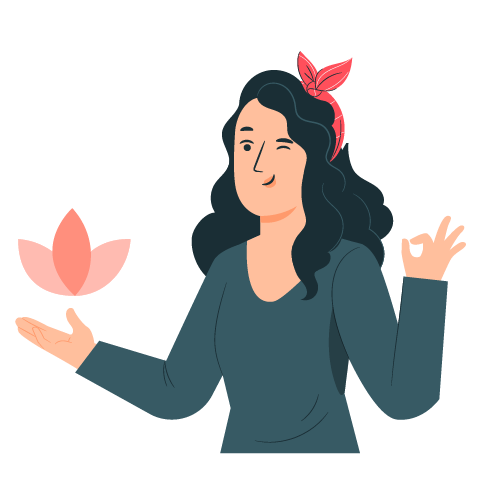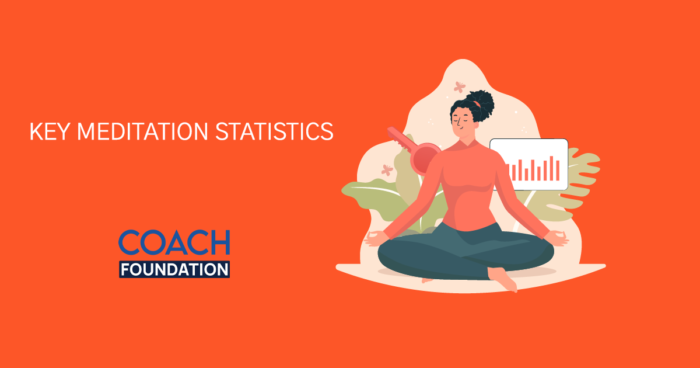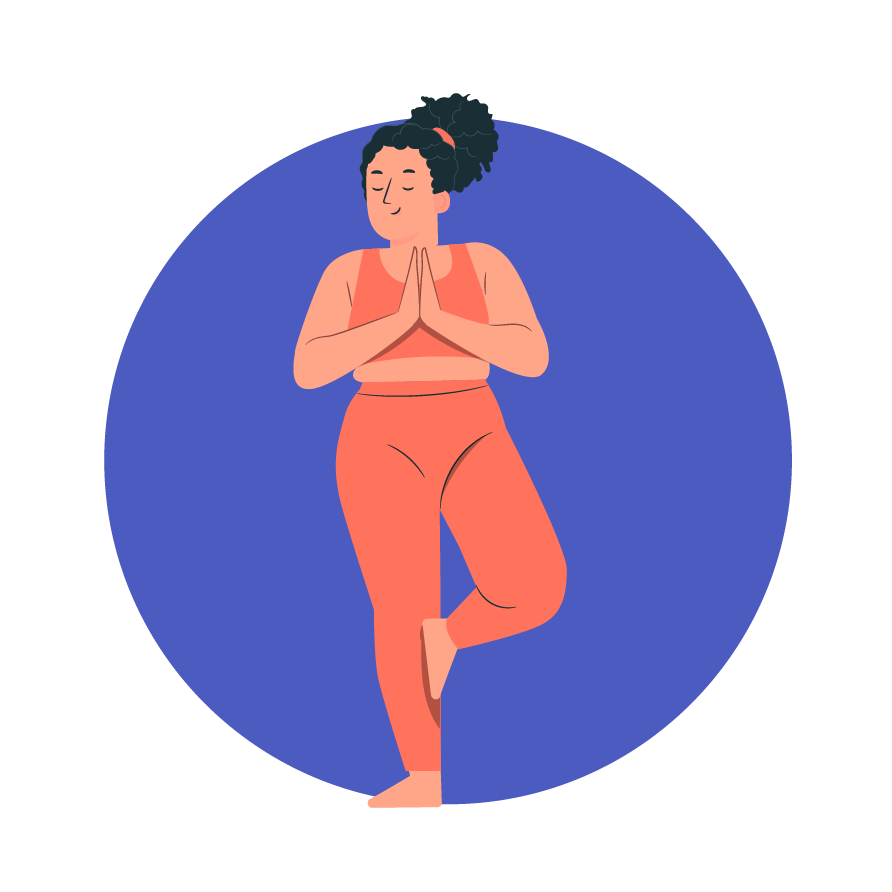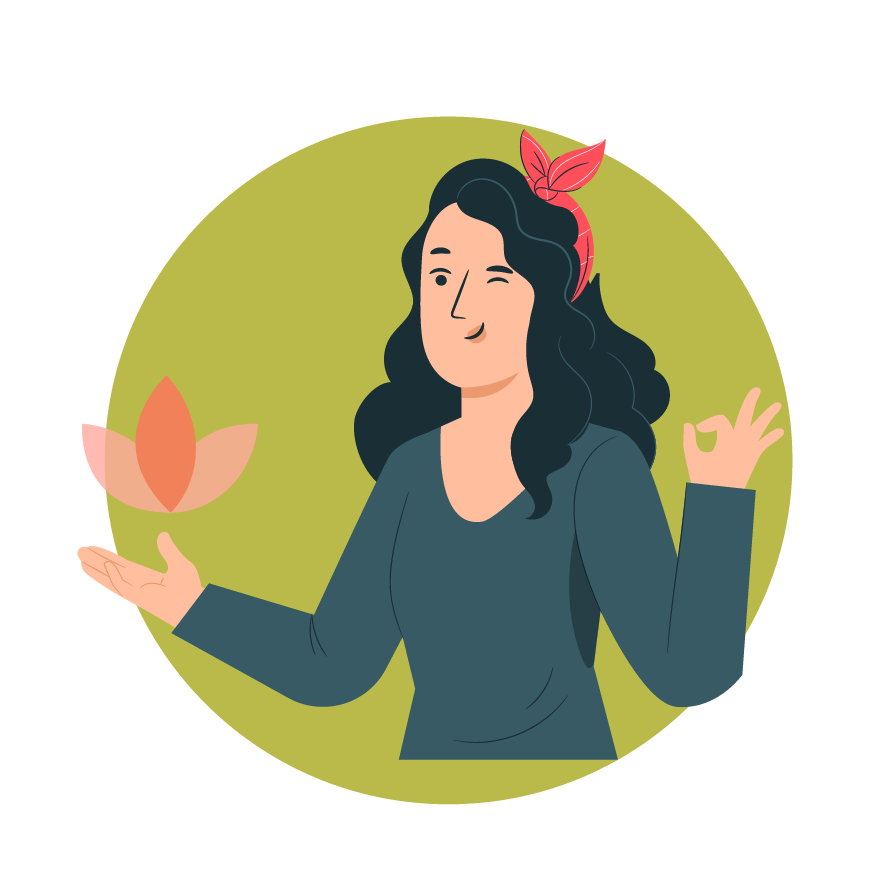Blog » Statistics » 132 Key Meditation Statistics For 2022
132 Key Meditation Statistics For 2022
This is an extensive list of the current most important statistics regarding meditation for 2022. All the stats are developed by accessing over 215+ public resources, forums, blogs, and more.
The stats undergo frequent changes and upgrades. They are constantly evolving, changing their products, campaigns, and strategies based on current stats. Requirements are also adjusted every six months as the meditation statistics learns more about its target market and outdated data has been renewed by the current.
On this page you’ll find hand-picked stats about:
- Industry Trends
- Demographics
- Biological benefits
- Workplace meditation
- Lifestyle improvement
And a whole lot more.

Data is the most important part of all your professional decisions, so let’s take a deeper dive and explore the data!
Contents
chapter 1:
Market, Growth, and Opportunities
Let’s begin by exploring what you need to know about the meditation market, why it is so valuable, and how this sector could help you achieve sustainable growth through effective strategies. I’ve managed to track down some of the standout statistics relating to this market, their significance, and how an entrepreneur can take advantage of the opportunities available in this sector!

- Over 14% of US adults have attempted meditation at least once.
With an approximate adult population in the US of 253 million adults that works out at nearly 36 million people.
Another chunk of research, published by Pew Research Centre in 2014, inferred the number was even higher. They reported that as many as 40% of Americans state to meditate at least once a week. (Source)
- Since 2012 the number of people exercising meditation has tripled
A 2012 survey noticing at Complementary and Integrative Health Approaches, observed yoga, meditation, and chiropractic care as the most prominent Mind and Body practices.
Meditation is now the second most prominent Mind and Body practice in the US. This makes it more famous than seeing a chiropractor and places it just behind yoga, which is also verified to be a huge thriving trend. (Source)
- The most prominent Mind and Body practices in the US, based on research in 2017
- Yoga (14.3%)
- Meditation (14.2%)
- Chiropractor (10.3%)(Source)
- 4.7% of children in the US are into meditation.
This statistic recorded in 2017 is a huge increase from 2012 when the figure was just 1.6%. The expansion is due to many US schools now comprising mindfulness practices, including meditation, as part of their curriculum.
It’s thought that meditation can enable to manage the stress and anxiety that many young people face today, and be optimistic for several childhood circumstances. (Source)
- 4% of women are more likely to meditate than men.
Data from the National Health Interview Survey in 2017 indicated that 16.3% of women used meditation, correlated to 12% of men.
Little is known about why women select to practice more, however, research does exhibit that they can enjoy more advantages than men.
It’s assumed that the explanation for this is down to the way different genders process emotional discomfort.
Men tend to externalize their feelings, whereas women internalize and ruminate over a problem, an emotional response that can react well to meditation. (Source)
- 16% of adults aged 45-64 meditate, making them the most devoted meditators
However, the popularity of the practice is extensive across the age groups, with the 18-44 and 65 and over group not far behind with 13%. Here is the popularity of meditation by age group:
- 45-64 age group (15.9%)
- 18-44 age group (13.4%)
- 65+ age group (13.4%)(Source)
- As meditation endeavors into virtual reality, the industry is expected to grow rapidly to $3.9 billion by 2023.
Apps that allow you to flee everyday life and analyze peaceful settings through a VR headset are an enormous growing trend. (Source)
- Meditation can chop the wake time of insomniacs by at least 50%
A 2008 study at Stanford University Medical Center, shapes part of a wider look at the consequence of mindfulness practices, encompassing meditation, on sleep difficulties. (Source) - Meditation has been exhibited to reduce depression reversions by 12%
Research at the University of Colorado looked at pregnant women who were at an elevated risk of formulating postpartum depression.
Results accentuated that those pursuing the meditation program had an 18% depression relapse rate compared to a 30% relapse rate overall. (Source) - According to current meditation studies, 76.2% of people turn to meditation for health.
Among other important reasons for meditating were enhancing energy (60%) and benefiting memory and attention (50%). Fewer people named anxiety (29.2%), stress (21.6%), and depression (17.8%) as health issues for which they meditate. (Source) - Meditation statistics reveal that meditation studios produced $659 million in revenue. Meditation studios in the US are closely related to yoga studios. Both of these have improved in popularity enormously in the last few years. About 2,450 meditation studios are effective, most of which are nonprofit organizations. The nonprofits develop around $165,000, while the for-profit ones gross much more, $269,000. (Source)
- The mindfulness app Calm generated $1,983,380 in revenue, which is an indication of the meditation’s popularity. In the digital age, people have apps for everything. Some serious apps have been formulated over the years, and Calm is number one when it comes to usage. The second place is taken by the app Headspace, both when it arrives at the revenue and downloads. People support platforms where they can practice mindfulness meditation, one of the most popular categories of meditation out there. (Source)
- Meditation statistics for 2021 demonstrate that 40% of Americans meditate weekly. All over the world, people are finding out the therapeutic qualities of meditation, and they’re practicing it more and more often. Nearly half of Americans meditate regularly, this statistic on meditation implies. Only 4% of the population in the US meditates just a couple of times a year, 8% meditates up to twice a month, and 45% of Americans say they meditate hardly or never. (Source)
- Statistics on people practicing mindfulness disclose that 35% of people meditate to curtail stress. People have various reasons for turning to meditation. However, a large fraction of the population has stress issues, and that’s where the advantages of meditation are the most helpful. When that’s contemplated, it’s no surprise that a bit more than a third of meditation users turn to meditation for that very reason. (Source)
chapter 2:
Demographics
Here is a comprehensive list of the traits of different types of meditation coaches. There are three categories for this article – the age or generation of the coach practitioners, gender-related stats about executive coaches, and types of clients that are served by the coaches.

- 66% of Buddhists in the US meditate weekly or more often than other religions. It’s not unusual that Buddhists are toward the top among meditation users assessing their religious practices. However, Jehovah’s Witnesses meditate the most, with 77% performing it at least once a week. Mormons (60%) are next on the list, pursued by Catholics (40%), Muslims (36%), Hindus (33%), and Jews (28%), according to mindfulness statistics. (Source)
- 94% of women reveal meditation is helpful. Men and women have varied practices when it comes to meditation. As mindfulness statistics show, 90% of men uncover meditation as useful and helpful. According to our fitness industry statistics, men like going to the gym more than women, while women are more enthusiastic about meditation. (Source)
- As of 2017, non-Hispanic white adults were most likely to utilize yoga or meditation or attend a chiropractor. People of all ages, genders, education levels and careers have tried meditation and, in most cases, like it. When it comes to gender, in 2017, women turned to all of these strategies more often than men did. Non-Hispanic white adults were the most likely to participate to make the popular meditation trend even more so that same year. (Source)
- 14.2% of adults exercised meditation in 2017. In 2012, just 4.1% of Americans were meditating. Along with other forms of alternative medicine, meditation has amassed its place in Americans’ lives over the years. Namely, in 2017, the number of people who meditated had tripled. The usage of yoga increased considerably as well, from 9.5% in 2012 to 14.3% in 2017. (Source)
- Teens meditation statistics demonstrate that 5.4% of American children practiced meditation. Meditation was the first option for older children. In fact, meditation grabbed first place for 6.5% of kids aged 12 to 17 in 2017, while chiropractors were the favorite in 5.1% of cases. (Source)
chapter 3:
Benefits of meditation based on population stats
Digging into the widespread benefits of meditation based on the population stats, revealing the data by how much meditation has simplified their daily lifestyle and reduced the chances of suffering from ailing diseases, meditative plans taken in the workplace, and much more.

- Meditation is beneficial when it comes to chronic pain problems. Chronic pain statistics exhibit just how awful and hard this issue is. Luckily, due to the advantages of meditation, this problem can get at least a bit less serious. Even though the fact isn’t of high quality, it still is there, and it could pave the road to some modern research and even better findings. (Source)
- Meditation enhances memory, as proven by numerous mindfulness meditation researches. Mindfulness meditation is one of the most naturally used procedures of meditation. Awareness meditation appears second on the list of everyone’s favorites. It’s no wonder these two are so valuable. As the science of meditation exhibits, the activity influences your cognitive processes, improves them, and helps you never skip anything! (Source)
- Meditation assists with lower back pain. Patients with lower back pain were studied in two distinct approaches: mindfulness-based stress reduction and cognitive-behavioral therapy. The outcomes were very identical, and there was nothing that would confirm that meditation doesn’t help with this problem as much as other strategies. (Source)
- When it comes to meditation at the workplace, statistics indicate that 22% of companies had mindfulness policies in 2016. Workplace stress statistics indicate how and why people are stressed at work. Fortunately, as statistics on meditation show, some bosses understand why they don’t profit from burnt-out and stressed-out employees. In fact, 21% of participants in the same survey said they were speculating about initiating a mindfulness program by 2017. A third of the companies that had already organized such programs even authorized participation by spouses and dependents. (Source)
- Meditation facts demonstrate that the oldest written evidence of meditation perhaps dates as far back as 5000 BCE. We’re witnessing meditation becoming popular in boosting degrees, each day. Today, this helpful practice is done all over the globe. However, it appeared in India many millennia ago. Meditation, as well as yoga, didn’t reach the United States until the 20th century. From the 1960s onward, meditation began earning the degree it deserves in many cultures and communities. (Source)
- Mindfulness statistics for 2021 exhibit that the largest online meditation lesson compiled 33,061 people. The Chopra Center for Wellbeing (USA) holds the title for the largest meditation lesson, held online on August 8, 2014. The 30-minute long session was led by Deepak Chopra and Gabrielle Bernstein. The users simply logged on to the website to participate in this historical moment. (Source)
- It’s computed that 200–500 million people meditate worldwide. In recent years, the meditation stats reveal that the practice has been amassing popularity. Assessing all the health benefits it offers, it’s no amazement that an increasing quantity of people use it. (Source)
- Over 14% of Americans have meditated at least once. Additionally, Pew Research Center’s research suggests that this percentage could actually be much higher, with 40% of US adults meditating at least once a week. (Source)
- In 2017, 14.2% of US adults said that they’d meditated in the past 12 months. The CDC’s report “Use of Yoga, Meditation, and Chiropractors Among U.S. Adults Aged 18 and Older” is a great reference of relevant statistics on meditation. According to its outcomes, the percentage of people who use meditation has boosted considerably from 2012, when only 4.1% of Americans had meditated the prior year. (Source)
- The majority of people practice meditation to boost their general wellness and vigor. About 76% of people using meditation said that general wellness is their major goal. Furthermore, mindfulness meditation statistics show that other explanations for meditating comprise improving energy levels (60%), improving memory and concentration (50%), and alleviating anxiety, stress, and depression. (Source)
- Meditation enriches anxiety levels 60% of the time. After meditating for 6–9 months, almost two-thirds of those suffering from anxiety managed to lessen their anxiety levels. (Source)
- Meditation can decrease the risk of being hospitalized for coronary disease by 87%. Meditation studies disclose that people who meditate are less liable to suffer from heart disease. Since meditation is a sort of relaxation technique, it reduces stress, which is a well-known cause of many significant medical conditions. (Source)
- Meditation alleviates the symptoms of insomnia 75% of the time. The majority of people with insomnia who meditated on a daily basis were able to fall asleep more promptly. In fact, 75% of them needed only up to 20 minutes to doze off. Additionally, 91% of insomniacs reduced or eradicated their use of sleeping medication. (Source)
- Meditation can decrease PMS symptoms by 57%. Based on meditation research articles, women practicing meditation discovered a deduction in both the physical and psychological PMS symptoms. (Source)
- Meditation can decrease the wake time of people with insomnia by 50%. Based on the research evaluating how beneficial mindfulness-based therapy for insomnia is, meditation can positively affect insomniacs. (Source)
- Practicing meditation can have favorable effects on relieving back pain problems. Mindfulness meditation encouraged people with back pain to enhance their ability to do daily chores by 30%. This is one of the verified physical usefulness of meditation, according to mindfulness meditation studies. (Source)
- Mindfulness meditation can curtail symptoms of post-traumatic stress disorder 73% of the time. A study examined the efficacy of mindfulness-based cognitive therapy for treating PTSD in veterans. Considering that 73% of them exhibited reduced symptoms, further research on the impacts of meditation should be performed. (Source)
- Meditation may decline blood pressure 80% of the time. Scientists have found out that exercising meditation is helpful for hypertensive patients. According to meditation stats, 80% of them lowered their blood pressure and desired fewer medications thanks to meditation. Additionally, 16% of them were able to quit taking their medications for hypertension. (Source)
- Practicing meditation can improve your attention duration after only 4 days. In addition, a study showed that practicing mindfulness meditation for a short time may improve visuospatial processing, memory, and executive functioning. (Source)
- Meditation can expand grey matter. According to a Harvard study, practicing mindfulness meditation for at least 30 minutes a day can boost grey matter in the hippocampus. This is one of the more significant meditation facts since this part of the brain plays a crucial role in memory and learning. (Source)
- There’s an enormous number of women who meditate than men. According to the 2017 National Health Interview Survey, 16.3% of women used meditation correlated to 11.8% of men. (Source)
- 15.2% of white adults were into meditation in 2017. They were more likely to use meditation to black (13.5%) and Hispanic (10.9%) adults. This indicates that in the case of meditation, its popularity differs across different population groups. (Source)
- Adults aged between 45–64 age range are the most likely to use meditation. 15.9% of adults in this age group utilized meditation in 2017 compared to 13.4% of adults in both the 18–44 and 65+ age groups. (Source)
- 66% of US Buddhists meditate at least once a week. This fact may not come as a surprise. However, Americans across other religious groups also practice meditation on a regular basis. For example, 49% of Evangelical Protestants meditate at least once a week, while the percentage of Jehova’s Witnesses doing the same is even bigger, at 77%. According to these meditation facts and statistics, even about 25% of people who don’t belong to any religion and don’t announce themselves as atheists practice meditation just as frequently. (Source)
- Almost 10 times more children performed meditation in 2017 than they did in 2012. In 2017, 5.4% of children aged 4–17 had meditated in the past twelve months, compared to 0.6% in 2012. The percentage of boys and girls who used meditation was very comparable. (Source)
- A greater percentage of children aged 12–17 used meditation compared to younger children.
When it comes to teens, the meditation statistics from 2018 disclose that 6.5% of older children used meditation compared to 4.7% of children aged 4–11. There were no substantial differences in the use of meditation among distinct races. (Source)
chapter 4:
Meditation in the workplace, technology, and educational sector
Moving further to see the role of meditation in the workplace, technology, and educational sector.
Comparing data on how much it has increased the employee’s productivity, student’s concentration power, and what all plans were taken to introduce mindfulness.

- Headspace, a meditation app, has had about 40 million downloads.
According to Apple, mindfulness apps, encompassing meditation apps, were the number one app trend in 2018. (Source) - The meditation and mindfulness industry received almost $1 billion in 2015.
However, this chunk of meditation industry statistics doesn’t comprise the revenue from mindfulness apps or the wearable gadgets used during meditation. (Source) - By 2022, the significance of the US meditation market will be a bit over $2 billion.
According to Marketdata’s results, the value of the meditation market rose from $959 million to $1.08 billion in just one year, from 2015 to 2016. It’s calculated that its annual growth will average 11.4%. (Source) - 52% of employers delivered mindfulness classes or training to their employees in 2018.
This piece of data comes from an annual survey carried out by the National Business Group on Health (NBGH). Comparing the NBGH’s meditation workplace statistics, this marks a significant increase—from 36% in 2017 to 52% in 2018. (Source) - Meditation can boost employees’ productivity by 120%.
Additionally, employers who introduced meditation to their employees claim that work absenteeism reduced by 85% while earnings increased by 520%. (Source) - Meditation was a component of the curriculum in 91 US schools in 2012.
More and more schools are introducing meditation as part of their curriculum because of its various advantages. Among other things, it can curtail class absences and aggressive behavior. (Source) - School suspensions were lessened by 45% gratitude to meditation.
One school witnessed a decline in school suspensions after introducing a meditation program. This information on meditation in schools and the statistics associated with it are further proof that meditation can be helpful in the classroom since it’s speculated that it can boost children’s achievement. (Source) - In the US, adult use of meditation tripled in 2017; it went from 4.1% in 2012 to 14.2% in 20171
Mindfulness is a state of awareness that arrives from purposefully paying awareness to your thoughts in the present moment in a non-judgemental way. People often correlate mindfulness with meditation. The practice of meditation is an ancient mind-body technique that has been used to enhance psychological well-being. Mindfulness is not about concealing positive or negative thoughts; instead, it assists us to free ourselves from our habitual thought patterns. It is significant to note that the profits of mindfulness practice appear over time and not instantly after the first session. (Source) - 45% of Americans barely meditate or do not prac4tice meditation at all
Although the past of mindful meditation is correlated with eastern spirituality in popular culture, it has traversed religious boundaries. According to a 2018 report by Pew Research Center, nearly all Americans who belong to a religious group meditate. 26% of non-religious Americans meditate weekly or more often. They averaged the meditation frequency of both sections to at least once a week. (Source) - In 2018, 8 million adults in Britain had learned to practice mindfulness, while around 12 million had never given attention to mindfulness
Mindfulness training expects learning the techniques used to bring the mind and body to a mindful state. These techniques include body scanning, mindfulness yoga, mindful eating, mindful listening, breathing, and walking meditation. Learning to use these techniques in the right way will decrease mind wandering and help focus on our thoughts and actions in the present moment. (Source) - 43% of people in Britain stopped practicing mindfulness right after learning, 32% practiced from time to time, while 25% practiced regularly
In most situations, practicing mindfulness meditation employs a quiet environment that is devoid of distraction. For most adults, such an environment is a luxury, even for a short period. The distractions of work and family may stave off many people from taking time out to practice mindfulness.
Statistics show that young unmarried adults practice mindfulness more often than married people. Also, more than one report exhibited that women were more involved in mindfulness practice than men.
Related: Have a browse of these mindfulness quotes to comprehend from those who’ve taken mindfulness practice to heart and benefit every day. (Source) - A 2018 study showed that mobile apps were the most used pathway to practicing mindfulness in Britain, proceeded by books and following a course
In 2018, 15% of the adult population of Britain had learned mindfulness practice via an app, a book, or attending a program. Technology has instilled almost every aspect of life, and wellness is no exception. There are many routes to access mindfulness programs, but an app is favorable for most young people. This may be due to busy schedules and other commitments.
Using apps means they don’t have to book an excursion to a mindfulness retreat, and they can pace their training according to personal convenience. This also means they can practice anywhere and anytime. The downside of mobile phone apps as a device for practicing mindfulness is that other apps may result in distractions frequently. (Source) - British politicians in the UK parliament have been informed about mindfulness practice
Mindfulness is considered a safe practice for anyone. You don’t need to have special skills or subscribe to some religious assumptions to be mindful. Anyone with an open mind to the practice can admire the mental and health usefulness of mindfulness. (Source)
chapter 5:
Biological miracles by performing meditation
You must be aware of spiritual enhancement from meditation but are you aware meditation helps in gene regulation? Plunging into the biological benefits of performing meditation and its effect on holistic development, regrowth of the cells of the body.

- Research has shown that practicing mindfulness condenses areas of the brain that control ‘executive function’ such as the prefrontal cortex, hippocampus, and amygdala
Despite complications, mindfulness research has endeavored to deliver valid evidence of the advantages of mindfulness meditation concerning mental health and general well-being. One of the hard chunks of evidence is the thickening or strengthening of the grey matter in the prefrontal cortex, insula, hippocampus, precuneus, and amygdala.
The prefrontal cortex is the region of the brain in charge of self-regulation, attention, and planning. The insula and precuneus are accountable for self-awareness and emotional regulation. The hippocampus takes care of memory functions, and the amygdala is linked with feelings of fear, anxiety, depression, and stress. (Source) - A study by Harvard scientists recorded a change in 172 genes governing inflammation, glucose metabolism, and circadian rhythms linked to a significant decrease in participants’ blood pressure after about eight weeks of meditation7
Many studies have shown that meditation can help control or treat high blood pressure, chronic pain, and some mental disorders. Research also implies that meditation may help reduce insomnia, anxiety, and irritable bowel syndrome. (Source) - Women are 4.3% more likely to meditate than men.
When talking about meditation facts and statistics, 12% of men meditate and practice mindfulness, compared to 16.3% of women. According to Rahil Rojiani, co-lead author of a Brown University study on meditation, mindfulness may help women lessen negative emotions like guilt and nervousness, and it can help them become more self-compassionate. (Source) - 15.9% of people between the ages of 45 and 64 meditate and practice mindfulness.
According to statistics on mindfulness, the greatest percentage of people who meditate is between the ages of 45 and 64, compared to the percentage of 18-44-year olds and people above the age of 65 (both 13.4%). All in all, this holistic practice is extensive across all age groups. (Source) - Meditation stats reveal that 89% of students who meditate have enhanced emotional regulation.
The same survey results found 83% of students who meditate and practice mindfulness report enhanced focus, while 79% claim to be more committed during their classes. (Source) - 80% of hypertensive patients who meditate unfailingly have reduced medications and lowered blood pressure.
According to this statistic on meditation by Mind/Body Medical Institute, 16% of hypertensive patients were able to quit taking their medications totally. Not only that, but these extraordinary results lasted a minimum of three years. (Source) - Headspace was worth around $250 million in 2017.
Headspace is a meditation app that functions as a guide to mindfulness in everyday life. The app authorizes you to learn mindfulness skills from professionals, such as the co-founder of Headspace, Andy Puddicombe. (Source) - Globally, 200-500 million individuals meditate.
According to the latest proof, the number of individuals practicing meditation and mindfulness has tripled since 2012! This improvement is definitely a good thing, as this implies that more and more people are taking care of their mental health. (Source) - More than 15% of American Adults Have Tried Meditation at Least Once in Their Lives.
With an adult population of more than 250 million, about 40 million work out periodically. Research disseminated in 2014 implied that 40% of the population meditate at least once weekly. Pew Research Centre verified this report. This stat proves that while meditation hasn’t always been the most popular form of exercise for Americans, it is substantiating to be more and more popular as time goes on. The fact that 40% of the population meditates at least once a week is also incredible, especially for a western country. (Source) - A Survey in 2017 Shows Body and Mind Practices Across Different Us Geographies.
The popular practices are rated in percentages as Meditation(14.2%), Yoga(14.3%), and chiropractor (10.3%). The great news is that with this stat, you know that meditation is about so much more than just exercise – it is a holistic approach to health that can exemplify itself in a number of different ways. Meditation has a way of assisting your body and your mind at the same time. (Source) - Individuals Practicing Meditation Have Tripled Since 2012.
Other research in 2012 shows chiropractic care, meditation and yoga are standard body and mind practices in the US. Complementary and Integrative Health administered this study. Meditation is the second most popular after yoga, as chiropractic care holds third place. The body and mind practices have tremendous growing trends. (Source) - A Survey in 2017 Shows Body and Mind Practices Across Different Us Geographies.
The popular practices are valued in percentages as Meditation(14.2%), Yoga(14.3%), and chiropractor (10.3%). The great news is that with this stat, you know that meditation is about so much more than just exercise – it is a holistic strategy to health that can exemplify itself in a number of different ways. Meditation has a way of assisting your body and your mind at the same time. (Source)
chapter 6:
Effect on meditation in student suspension rates
Moving ahead to see the effect of meditative practices and mindfulness among students, that has certainly decreased student suspension rates, violent actions, and hyperactivity.
Also, increase in psychological well-being.

- A Survey in 2018 Shows that More than 50% of Employers Provide Meditation Training for Their Staff.
The result was a 36% improvement correlated to the prior year. The National Business Group on Health (NBGH) demonstrates that more corporate bodies are introducing stress reduction programs to improve the productivity of their employees. (Source) - In 2012, More than 90 Schools Featured Meditation as A Course in Their Curriculum. the 91 Schools Are Across 13 States.
Although the recent number of schools offering meditation as part of their curriculum in the US is not validated yet, educational experts have indicated it should be a crucial part of learning. About 41,000 teachers in the United States use the Calm app for classroom and home learning activities. (Source) - Statistics Show that Student’s Suspension Rates Reduced by 45% After Introducing Programs that Improve Mental Wellness in A School.
Visitacion Valley Middle School has expanded cases of violence. Therefore, the school authorities introduced ‘Quiet Time’ to put an end to violence. Likewise, the students could learn better with group meditation. After a month of the program, they reported a 98% happiness level in the state school survey after a year. (Source) - The global meditation industry will be worth $9 billion by 2027.
The meditation industry’s value should continue to thrive at an expected CAGR of 10.4% through 2027. Meditation trends show a rise in the practice all over the world, but the United States continues the undisputed meditation gold rush. Market researchers valued the US meditation market at $1.21 billion in 2017. As a point of reference, the wellness industry as a whole was esteemed at $4.5 trillion in 2018. (Source) - In 2019, the top 10 meditation apps generated over $195 million in revenue.
The accessibility of apps as learning aids clearly contributes to the meditation explosion. Although the top spots in the app store have been overlooked by a select few apps, that dominance seems rock solid. In 2015, the top 10 meditation apps only made about $8 million. In 2018, that number leaped to $128 million, according to the meditation statistics—meaning there was also a 52% boost just between 2018 and 2019. (Source) - Meditation data exhibits meditation studios generating over $650 million in the US every year.
Yoga studios have been prominent for decades now, but meditation studios are commencing to catch up. On average, a for-profit meditation center in the US produces about $269,000 in yearly revenue. (Source) - Almost 15% of US adults meditate, according to the statistics on meditation from 2017.
Research from a National Health Interview Survey exhibited that nearly triple the number of US adults meditated in 2017 compared to 2012. At the time of each survey, the portion of people who had meditated within the previous 12 months rose from 4.1% in 2012 to 14.2% in 2017. The number of children aged 4–17 who meditated also prospered from 0.6% to 5.4% in the same period. It’s hard to say precisely how many people meditate since the data is self-reported, but there’s no denying that these numbers are on the rise. (Source) - Research involving over 3,500 participants shows meditation can decrease anxiety.
Lessening stress and anxiety are among the top purported advantages of meditation. However, it’s questionable to find data that generates qualitative effects. To arrive at credible results, researchers compiled 47 scientific pieces of research on meditation with 3,515 total participants. The findings exhibited that mindfulness meditation lessened anxiety after only eight weeks of practice. (Source) - 15 minutes of relaxation-response meditation can vary the way your genes regulate
A study from Harvard looked at the effects of meditation on patients with hypertension. Shockingly, the mind-body relaxation response practices used in the study altered gene expressions in 172 genes. The affected genes regulate glucose metabolism and inflammation response, among other processes. (Source) - At least 40 minutes of meditation can generate significant differences in brain connectivity.
A study of 34 healthy participants investigated the consequences of transcendental meditation on brain activity. The participants, who meditated for 40 minutes every day, indicated increased connectivity between several cerebral areas correlated with mood regulation. MRI scans ascertained the impacts of meditation, and participants also documented reduced statuses of stress and anxiety. (Source) - Even more outstanding meditation benefits: statistics show that meditating as a part of heart rehabilitation treatment can enhance cardiac blood flow by over 20%.
Positron emission tomography (PET) cardiac scans suggest meditation can enhance heart health in coronary heart disease patients. The treatment regimen implicated meditation in addition to other lifestyle modifications, including exercise and dietary counseling. Researchers found that meditation heightened the effect of these interventions. A co-author of the study even contended that transcendental meditation alone reversed some impacts of coronary heart disease. (Source) - Meditation retreats enhance psychological well-being for up to five months.
The Shamatha Project is an extensive study on the advantages of meditation retreats in the form of randomized controlled trials. Participants self-reported substantial developments in several categories in one such trial, including well-being and mood. Participants of the retreats also underwent significantly improved attention spans. So if you’re trying to cut back on your morning coffee, maybe meditation can help. The health benefits prevailed for five months after the retreat. (Source) - Meditation is capable of decreasing pain by up to 40%.
A study from Wake Forest University ascertained these meditation facts on the subjective experiences of pain. MRI scans of 15 volunteers indicated that learning to meditate decreased the sensations of pain by approximately 40% when researchers elicited pain. The same did not hold for participants who weren’t equipped in meditation. (Source) - Meditation stats associated with PTSD treatment exhibited positive effects in 19 randomized control trials.
A literature review evaluated randomized controlled trials with a total of 1,173 participants. Subjects with post-traumatic stress disorder showed development in PTSD symptoms when using corresponding health interventions, such as yoga and meditation. However, researchers found no discrepancy in the effect based on the type of intervention utilized. (Source) - Meditation and mindfulness practices enhance sleep quality.
Sleep and relaxation are among the most exceptional functions via meditation, according to statistics on mindfulness. A study of 49 adults with sleeping difficulties showed mindfulness and awareness practices elicited marked developments in sleep quality. The impacts of meditation for participants were bigger than they were for those given a structured sleep hygiene education. (Source) - One of the most intriguing facts about meditation is that it could make you kinder.
Researchers from the University of Wisconsin found a relation between meditation training and increased altruism. The behavior was also correlated with activating the brain regions linked to emotional regulation and social cognition. (Source) - Historically, most Buddhists didn’t meditate.
Although most people associate Buddhism with practicing meditation, it’s far less broad than it seems. Meditation was mostly practiced specifically by Buddhist monks and only became familiar among laypeople in the 20th century. (Source) - Approximately 67% of Buddhists in the US meditate at least once a week.
A considerable number of Americans—across all religious groups—report they meditate at least once a week. Unsurprisingly, Buddhists are near the top of the range, with two-thirds meditating once a week or more. However, Jehova’s Witnesses are the group with the most meditators by far. A full 77% say they meditate once a week or more. (Source) - According to last year’s meditation research, 2019 was a big year for meditation apps, with over 52 million downloads.
The top meditation apps have a significant active user base, but they’re increasing new users at a stunning clip as well. In 2019, new users accounted for over 50 million downloads of the top 10 meditation and mindfulness apps. The overwhelming leaders were Headspace and Calm. Calm peaked at 24 million downloads, while Headspace had 13 million new users over the period. (Source) - Yoga and meditation are the most popular choices in health trends in the US.
Yoga and meditation are associated with similar traditions, but yoga has been more popular by far in the US for a long time. However, in one of the most fascinating facts about yoga and meditation, meditation is likely to overtake yoga soon. In 2017, the rates of people practicing yoga and meditation in the US were similar (14.3% vs. 14.2%). However, meditators hopped to 14.2% of the population from an unremarkable 4% over only five years. (Source)
chapter 7:
Role of meditation in adults and its constructive impact on positive lifestyle
No wonder, meditation has significant, positive consequences that include less drug abuse, enhanced self-esteem, higher creativity, more vulnerability to accept criticism, lesser anxiety attacks, and reductive chances of getting potential diseases. Here is a comprehensive list made from interrogative research and study work.

- The number of people who meditate globally is computed to be anywhere between 200-500 million
While there is no apparent global data on meditation adoption and market size, a rough estimation of people who meditate globally is estimated to be between 200 and 500 million. With more people knowing just how effective meditation is to overall wellbeing, it is no surprise that more people are willing to engage in the practice. (Source) - 40 percent of adult Americans claim to meditate at least once a week
Statistics from Pew Research Center implied that around 40% of adult Americans contended to meditate at least once a week. The research further demonstrated that while religion plays a significant role in practicing meditation, not all people who meditate do so for religious reasons. (Source) - The number of people who meditate today has soared by 3 times since 2012
According to a report by CDC, the number of people who meditated in 2017 was three times more than in 2012, going from a measly 4.1% in 2012 to 14.2% in 2017. This is a result of the extensive growth of meditation studios, brands, apps, and mainstream awareness that facilitates meditation as a cheap and easy-to-use self-care practice. (Source) - More than 14% of Americans have contemplated practicing meditation at some point
Emerging evidence implies that about 14 percent of Americans – up from 9.5 percent in 2012 – have attempted meditation at least once in their life. Using 2019 census data on the American population, this summarizes to over 35 million Americans. The stresses and anxiety of today’s contemporary life may have something to do with this increase. (Source) - Meditation can decrease the wake time for people with sleeping problems by up to 50%
A study by the National Center of Biotechnology Information indicated that meditation is a unique approach to stress reduction and emotion regulation. Another comparative study on the mindfulness-based approach for insomnia treatment noted that meditation could be used to formulate adaptive ways among chronic insomniacs that can help them fight wake times and nocturnal symptoms. (Source) - Practicing meditation for 6-9 months can decrease anxiety by 60%
Research on whether mindfulness meditation enhances anxiety and mood symptoms exhibited that the clinical population tested reported 60% improvement for their anxiety and anxiety-related disorders. Patients who learned meditation were more resilient to stress and anxiety. (Source) - People with back pain were more likely to encounter a 30% development in their ability to carry out daily tasks compared to those only taking medication
Chronic back pain is a dominating cause of lost time, affecting up to 80% of U.S. adults. A recent study indicated that meditation may alleviate back pains by 30%. Meditation imparts adaptive, acceptance-based coping mechanisms to people suffering from chronic back pains. (Source) - Mindfulness meditation can decrease depression relapses by up to 12 percent
Some psychologists widely agree that meditation plays a critical role in governing depression and may lessen relapses by 12%. Further research exhibits that people who practice mindfulness regularly can more easily tell when they are at risk of a relapse, enabling them to take appropriate action well ahead of time. (Source) - Meditation may reduce PTSD symptoms 73% of the time
Research on the effects of mindfulness meditation has shown promising results that suggest that this self-care practice could curtail the symptoms of posttraumatic stress disorder in 73% of trauma-exposed individuals. This could give patients tools to commence an active and attractive lifestyle. (Source) - Meditation plays a significant role in postponing the onset and slowing the progression of Alzheimer’s disease by increasing telomerase enzyme by 43%
Recent research has shown that short daily meditation sessions may help ease the signs and symptoms of Alzheimer’s disease. Ideally, meditation enables an increase in the telomerase enzyme that protects the DNA caps/lids by 43%, thereby delaying the onset of A.D. Besides, meditation diminishes the risk of Alzheimer’s disease by promoting sleep, increasing wellbeing, up-regulating immune system genes, lessening inflammatory genes, and ameliorating depression. (Source) - Meditation directs to massive increases in regional brain gray matter density
Recent meditation statistics from various magnetic resonance (M.R.) images of the brain have demonstrated that long-term meditation practitioners have an improved gray matter volume than people who don’t meditate. The boost in the hippocampus gray matter has a resulting gain in learning and memory capabilities. Other regional grey matter sections also influence compassion, self-awareness, and introspection. (Source) - People who meditated over eight weeks altered the expression of 172 genes that regulate inflammation, circadian rhythms, and glucose metabolism.
In turn, this was associated with a meaningful drop in their blood pressure. (Source) - Women Benefit From Meditation More Than Men
A study by the Yale School Of Medicine found that women who meditate experience lessened negative thinking as compared to men. This may be possibly due to the gender-based emotional disparities between men and women and how the two genders respond and process emotional stress. (Source) - 45-64-Year-Old adults are more likely to use meditation than older or younger groups
Information from the National Center for Health Statistics shows that 15.9% of adults aged between 45-64 years practiced meditation in 2017. Adults under the age of 44 and over 64 years had a 13 percent chance to practice meditation. (Source) - Non-Hispanic white adults were 15.2 percent more likely to meditate
A 2017 study by the National Center for Health Statistics indicated that non-Hispanic were more likely to practice meditation than African Americans (13.5%) and Hispanics (10.9%). (Source) - Buddhists meditate 66% more than other groups
A study by Pew Research demonstrated that 66% of Buddhists meditate at least once a week, 6% meditate once a month and 7% meditate at least once a year. This comes as no surprise since meditation is an age-old practice among Buddhists. But statistics show that meditation is not an unusual practice to one religious group. In fact, 49 % Evangelicals documented having practiced weekly meditation, with 77% Jehovah’s witnesses also indicating that they meditate at least once a week with 25% of the people not affiliated to any religious group meditating once a week (Source) - 10X more children practiced meditation in 2017 than in 2012
The National Institutes of Health estimate that 1OX more children meditate today than in 2012. The national representative survey data disclosed that only a negligible 0.6 % practiced meditation in 2012 as compared to 5.4% in 2017. (Source) - Roughly 5% of all American kids (4-17 years) now meditate
Over the past few years, more American kids are now exercising mindfulness meditation, amongst other forms of self-care practices. Surprisingly, unlike their adult counterparts, both boys and girls exhibited no significant differences in the use of meditation among the two genders. (Source) - More older children practiced meditation than younger children
In 2017 alone, a study by the National Institute of Health implied that older kids above 12 years were practicing meditation more than their younger companions. While different races indicated different meditation practices, there was the least difference among children below 17 years. (Source) - The meditation market in the U.S. is valued at $1.22 billion
Meditation has become mainstream in the U.S. with an annual growth of 11.4%. Today, the meditation industry is worth over $1B and is rated to go over 2 billion dollars in 2022. (Source) - The top 10 mindfulness apps pulled in more than 195M dollars in 2019
Meditation apps have been the steering revenue earners in the self-care category. Headspace App led the pack by grossing more than $56 million in 2019 alone. Further meditation statistics show that over 52 million users had downloaded the top 10 meditation apps by 2019. (National Business Group on Health) (Tech Crunch) (Source) - By 2018, over 52% of employers had some requirement for self-care training and classes for their employees.
More employers are approving the idea of having self-care classes and meditation training for their employees as a way to improve productivity and employee retention. This is a significant increase from 36% in 2017. (Source) - Meditation sessions reduced school suspensions by 45%.
A Middle School in San Francisco introduced a program dubbed “Quiet Time” to decrease the violence rate and gang culture that would often find its way to the school from the neighborhood. Within just a month, the school had recorded a 98% attendance rate and a deduction of school suspensions by 45% thanks to this form of meditation. (Source) - Mindfulness Practices Reduce Post Traumatic Stress Disorder (PTSD) Chances by 73%.
A study conducted in 2018 shows that meditation helps curtail symptoms associated with self-blame & numbing cognitions. In addition, the report inferred that mindfulness helps to project positive feelings. (Source) - More than 5% of Children in The US Undergo Meditation Practices.
This statistic recorded in 2017 indicates a drastic increase from the previous 1.6% in 2012. Elementary schools in America now encompass meditation/mindfulness practices as a branch of the curriculum. The boosting number of meditations could be correlated with people’s impression that it helps alleviate anxiety and stress and helps enhance the mental strength of children. Among several religious groups, Buddhists and Hindus meditate the most. You might be surprised to learn that American children are getting in on the meditation trend, but this stat shows just how popular it is getting, even among kids. It’s cool to see that elementary schools in the states are integrating different ways of health and exercise into their curriculum. America is strife with mental health problems both in adults and children, including things like depression and anxiety, so coming up with holistic explanations that avoid traditional medication is a great option. (Source) - Women Are More Likely to Meditate Compared to Men.
A study by National Health Interview Survey indicates the data of women to men meditation comparison. The 2017 data report women as 16.3% while men are 12%. There is ongoing research on why women meditate more than men, as statistics show they enjoy more advantages. Some experts think that it can also be associated with processing emotional discomfort. Men can be outspoken with their feelings, whereas women ruminate when bothered about a problem. This emotional response could be an excellent strategy for a solution if utilized effectively. Women are known for externalizing their feelings as well, but sometimes it’s beneficial if they have a practical solution to an internal problem. (Source) - Adults Between the Ages of 45-64 Meditate More Compared to The Younger Generation. Data Shows They Hold 16% of the Statistic Irrespective of Gender.
Yes, meditation practices are common across various age groups as stats show that 45-65 and 18-44 years meditate more. Below is the data presentation in statistics; 18-44 (13.4%), 65+ (13.4%), and 45-64 years(15.9%). While this stat shows that there are more older adults that are into meditation right now, this necessarily doesn’t mean that the younger generation will pick up on it at some point and capitalize on a practice that has been assisting people for hundreds of years. While more adults that are older might be more aware of the concept of meditation, it has become a growing trend among millennials and is only set to become more popular as time goes on. (Source) - How popular is meditation? More than 14% of adult citizens in the United States have tried meditation at least one time.
Another interesting fact is that, in the United States, meditation is nearly as popular as yoga. According to research from 2017, the second most popular practice that implicates the “mind and body” is meditation (14.2%), pursued by chiropractic treatments (10.3%). (Source) - In 2017, around 5% of kids in the United States were meditating and practicing mindfulness.
The advantages of mindfulness are evident not only in adults but also in children. For example, it helps kids respond to stress before they start having tempers. Although many parents believe it is difficult to teach a child to meditate, in reality, it is simpler than most people think. According to Lorraine Murray, the author of Calm Kids: Help Children Relax with Mindful Activities, kids are typically more willing to try new things, such as meditation, than some adults. (Source) - Teens who follow an intensive meditation program for only one week can accomplish the same results as teens who spend less time on meditation over a few weeks.
According to mindfulness meditation statistics on teens, teenagers who expended time at Inward Bound Mindfulness Education retreats experienced improved emotional health and felt less depressed even three months after completing the program. According to meditation instructor Jessica Morey, a meditation retreat can help teens by immersing them in the environment. (Source) - Open-monitoring meditation increases creativity
Open-monitoring meditation concentrates on the person’s feelings, emotions, and feelings present in that moment. According to Leiden University’s research in the Netherlands, people who practiced open-monitoring meditation accomplished better on tasks that required them to come up with new ideas. Unlike them, people who practiced focused-attention meditation didn’t exhibit any significant signs of improvement in terms of inventiveness. (Source) - One of the advantages of meditation is having better memory recollection.
According to Catherine Kerr, a researcher at the Martinos Center for Biomedical Imaging and the Osher Research Center, individuals who practiced mindfulness had an easier time ignoring distractions, which is also why they displayed higher productivity levels than those who did not meditate. (Source) - Meditation can help decrease stress and anxiety while improving self-esteem and mood in individuals suffering from lung cancer.
When talking about statistics on meditation, relieving stress is one of the major advantages of mindfulness. Research has shown that mindfulness-based stress reduction (MBSR) and meditation may help reduce depression, pain, stress, and anxiety in people with lung cancer. Another study supported by NCCIH implied that mindfulness training could decrease inflammation provoked by stress. (Source) - 100% of patients withstanding from insomnia documented improved sleep after taking up meditation.
According to the Mind/Body Medical Institute’s same clinical conclusions, 91% of insomnia patients have either lessened sleeping medication use or entirely eliminated it. (Source) - Mindfulness and meditation stats indicate that meditation enables infertile women to have a 42% conception rate.
Meditation and mindfulness also help women who have fertility issues; according to the clinical findings, infertile women who meditate also have a 38% take-home baby rate. Furthermore, they exhibit decreased levels of anger, anxiety, and depression. (Source) - Meditation lowers cholesterol levels.
The outcomes were originated from a study dealing with mindfulness statistics and therapy and its effects on cholesterol levels in patients struggling with high cholesterol. Based on these results, meditation considerably decreases cholesterol levels compared to matched controls over eleven months. (Source) - Meditation reduces alcohol, cigarette, and drug abuse.
According to research that evaluated 198 independent treatment consequences, meditation and mindfulness exhibited a larger decrease in alcohol, tobacco, and illegal drug use than either prevention programs or standard substance abuse treatments such as relaxation training and counseling. (Source) - In 2019, there were around 2,450 meditation centers or studios in the United States.
These meditation centers or studios are largely non-profit organizations that generate $659 million in revenues. Yoga studios and meditation centers work closely, as both of these have grown in popularity in recent years. On average, a prominent meditation center or studio grosses around $269,000, while non-profits gross around $165,000. (Source) - A study showed reduced anxiety, depression, and negativity after an 8-week mindfulness meditation training
To test how meditation influences people who have no previous meditating experience, researchers carried out an experimental study on non-meditators aged 18-45. The control group listened to a 13-minute podcast daily while the experimental group participated in a 13 minute guided meditation daily. After eight weeks, the experimental group indicated decreased negative mood and anxiety scores. The group also showed enhanced working memory, recognition memory, and attention. The study established that brief daily meditation could have similar effects as more prolonged and more intense meditation experiences. (Source) - The reductive consequences of Meditation programs on symptoms of patients with anxiety disorders can last for up to 3 years after initial interventions
Mindfulness practice can cause alterations in brain structure and training of the mind. Experts consider such differences to be more permanent than behavioral changes. Hence the advantages of mindfulness are thought to be lasting. Meditation can decrease panic, anxiety, and depression symptoms in patients, with the effects lasting for up to 3 years after the initial meditation intervention. However, the usefulness of being in the present moment does not suggest that meditation be done only once every three years. It simply organizes the fact that the benefits of meditation and mindfulness last long after the period of practice. (Source) - Research shows a substantial impact of mindfulness in substance misuse
Findings have been made that reveal small and large impacts of mindfulness treatments in withstanding substance abuse. Mindfulness treatments help to reduce the stringency and frequency of substance misuse. It also helps to curb the craving for psychoactive substances and lessens the rate of relapse. (Source) - Embrace Criticism
It’s not often you see someone approve criticism with confidence or grace, much less real interest. Negative feedback is one of the least fascinating experiences we can have at work. And research has shown that poorly transmitted and poorly received criticism can slay productivity.
We recently shared 5 ways that mindfulness can assist you to accept criticism. I’m not saying it’s simple, because criticism triggers ancient reptilian fears filling us with fight or flight hormones like cortisol and adrenaline which shut down major parts of our brains.
But with a simple 5-step mindfulness protocol, you can shortly ground yourself and respond with presence. That’s a big deal. And it’s a skill many leaders need to develop. By mindfully breathing, slowing down, listening, observing your response, and considering the information, you can conquer that fight or flight response and keep moving ahead. (Source)
Conclusion
I hope you found this mega list of meditation statistics interesting and insightful.
Now I’d like to hear your thoughts:
Which meditation stat from this list surprised you the most?
Or maybe there’s a stat out there that I overlooked (it happens 🙂).
Let me know by leaving a quick comment below.














Keep the good content coming!